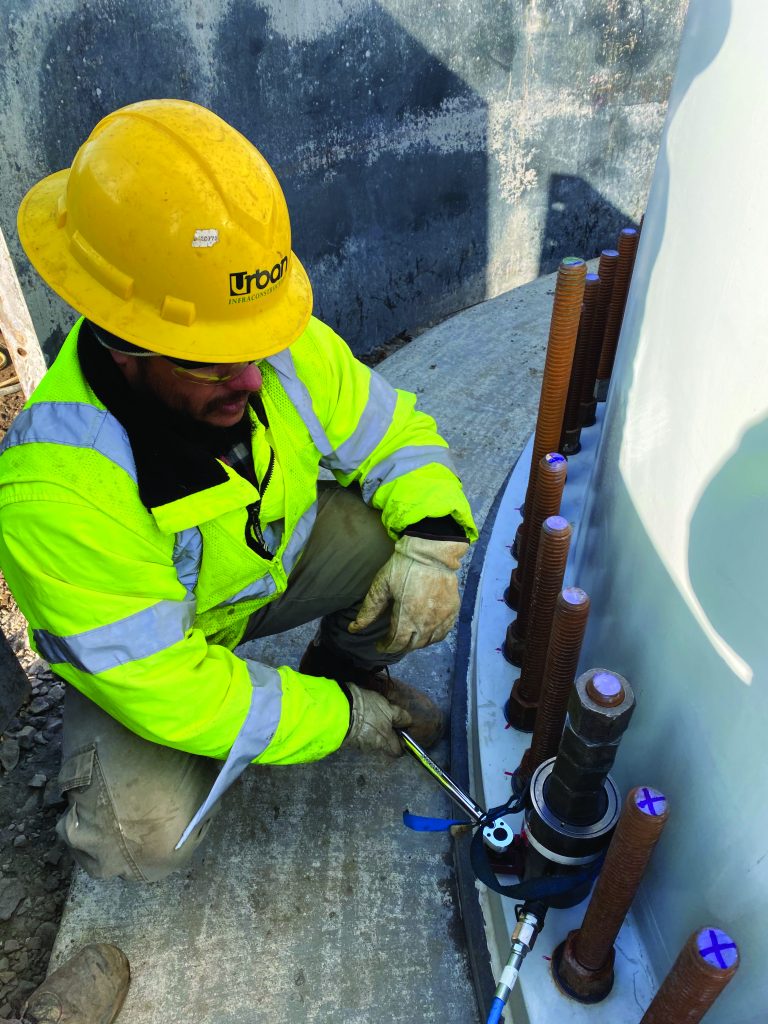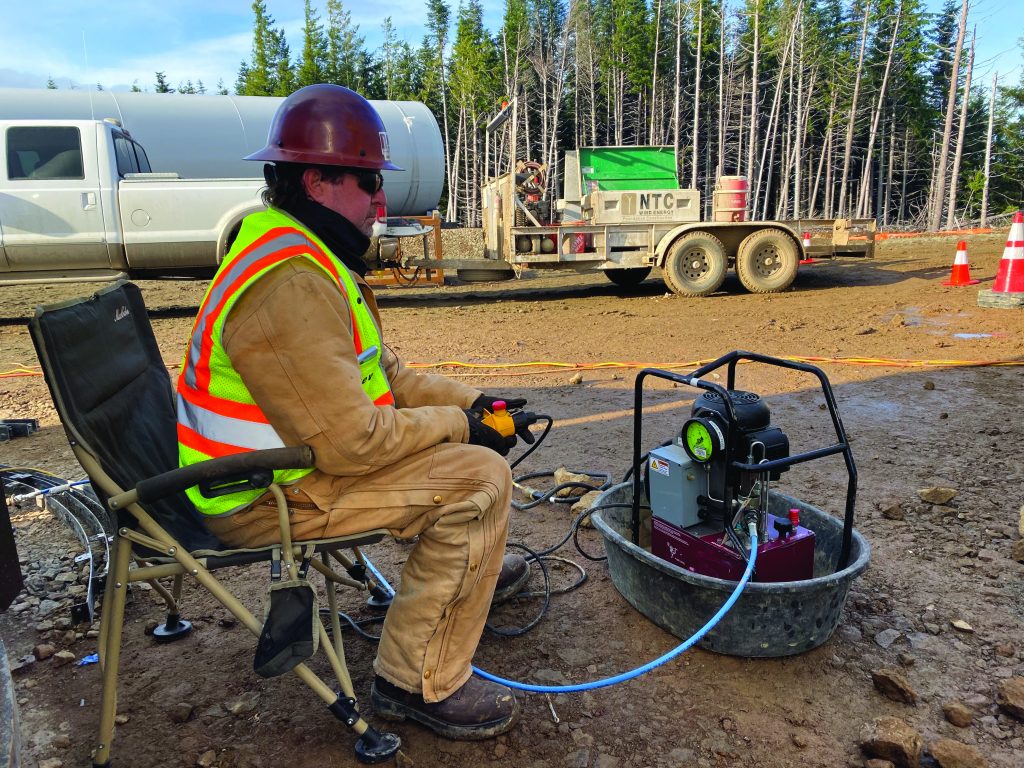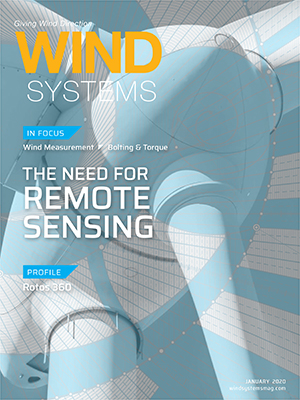If you are involved in wind-energy construction or operations and maintenance, you know that foundation anchor bolt tensioning requires careful attention to the equipment and procedures to achieve effective and precise results. There have been some real challenges of late as engineers design foundations with larger rods, more rods, and greater tension.
To date, the highest number of rods in a foundation combined with the highest required tension that we have performed is 192 #11 grade 90 rods at 105 KIP and 152 #11 150 ksi rods at 153 KIP. With the increasing number of rods in a foundation, there is very little space left for tensioning tools that can reach the level of tension being called for.
The Right Tools
The first challenge is finding the proper tensioning tools. The smaller the area to work with, the smaller the tensioning tool has to be. As the tool gets smaller, the effective working area of the hydraulic ram is necessarily reduced. This requires higher hydraulic pressure to achieve the desired tension. To determine the hydraulic pressure required to reach any desired tension, divide the desired tension in thousands of pounds by the effective working area of the cylinder in square inches. So, if you’re trying to reach 152 KIP (152,000 pounds) and your cylinder has an effective working area of 7.5 square inches, your hydraulic pressure is equal to 20,267 pounds. This is very near the top of a typical 21,700-pound cylinder and pump’s capacity. In the author’s opinion, it is best to maximize the effective working area of the cylinder and reduce pressures to protect the seals in the cylinder and pump.
With hollow-cylinder tensioning tools, there are two ways to run the nut down once the rod is pulled: the Tommy bar and the ratchet rundown gear. There are advantages and disadvantages to both.
The Tommy Bar Method
The Tommy bar method uses a socket around the nut with holes on its circumference properly sized to place the steel rod known as the Tommy bar into it. Once the foundation anchor bolt is pulled, the operator reaches into a window at the base of the tool and tightens the nut one notch at a time. The advantage of this method is that there are few moving parts to break. The disadvantages are that this method is very slow and most Tommy tools are made of mild steel that rounds off quickly. As a result, the tool slips out of the holes and takes even more time. In this case, a properly sized center punch is far better.

The Ratchet Rundown Gear
We like the ratchet rundown gear. It is made up of a pair of gears attached to a ½-inch drive ratchet. The nut can be turned in either direction for left-hand threads and right-hand threads, and it is substantially faster. The disadvantage to the ratchet rundown gear is that there are several moving parts that can break. However, the base portion of most hollow-cylinder tensioning tools splits in two with the ram on top and the socket with the rundown gear on the bottom. The socket portion of the tool is relatively inexpensive and easily interchangeable. It is advisable to have at least one replacement on site during tensioning. The operator should be cautioned to put the tool over the nut gently and make sure the tool sits flat on the flange of the tower base before running up the pressure.
Another way to avoid damage is to use a torque wrench set at no more than 40 pounds and instruct the operator to stop pulling on the wrench when the torque wrench clicks. Inexperienced operators will often bear down on the nut in the false belief that his or her strength makes a positive contribution to a rod tensioned at over the weight of a loaded 18-wheeler. Not only is this hard on the operator, but it can potentially break the rundown gear.
Difficult Nuts
Occasionally, especially in new construction, a nut will be difficult to run down on the rod. This is normally due to damaged threads or grout on the rod. A disadvantage of both the Tommy tool method and rundown gear method is that both give you very limited ability to overcome this difficulty. In this case, run the nut back up the rod and attempt to correct the problem. This seems like a good time to mention that it is important to avoid damaging the threads on the rods in the process of setting the base section of the tower on the bolt pattern.
Double-Cylinder and Push-Plate
If you are using a double-cylinder and push-plate setup, you’ll need to divide the desired tension by the effective working area of both cylinders to calculate your hydraulic pressure. The problem is that with such dense bolt patterns and high tension, it is not likely that a 30-ton flat jack, much less a 50-ton flat jack, can fit between the rods.
The rods can be pulled from the top with double-cylinder and push-plate equipment fabricated to reach down to the rod being tensioned, but this is less than ideal for several reasons. First, there are often grounding brackets, door flanges, and other accessories that will limit the clearance on top of the rods. Second, the rods are not always the exact same length or projection over the flange, meaning the push-plate would be pulling at an angle. This is not acceptable but can be compensated for by placing nuts on the adjacent rods being used as the bearing surface for the jacks and running them up or down to level the jacks.
The advantage of the double-cylinder and push-plate setup is that a large wrench can be used to run the nut down if there are defects in the threads of the rod.

Loss of Tension
Regardless of the equipment used to tension foundation anchor bolts, they always lose some tension on the first pull. This is primarily a result of foundation settlement and rod elasticity, among other factors. To compensate for this, mark down the nut and make a tick-mark on the flange. Run the nut up once and tighten it. Then, relax the tool, tighten the actuator on the top of the tool, and run it up a second time. Now, observe the rotation of the nut. This will give you a reference for all rods to see if you are deviating from proper tension. After completing the job, 10 percent of the rods should be re-tensioned at random. If any of them move more than a slight amount, the entire foundation should be re-tensioned.
The last test to perform is the “ping test,” which is simply to tap on each and every rod with a light hammer and listen to its tone. Rods are like guitar strings. When they have no tension, they thud. The more tension they have, the higher the tone. This is not a precise test. Some rods will ping slightly differently depending on their length and what they are in contact with under the foundation. It is only a test to determine that every rod has been tensioned. If a rod pings substantially different, it is advisable to note the elongation of that rod and the marks on the nut to determine whether the rod was tensioned within tolerance and/or re-tension it. It is not recommended to pull a rod repeatedly as they can hyperextend and lose elasticity altogether or break.

































